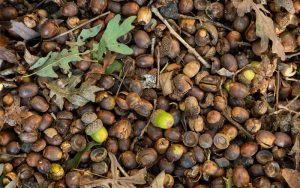
So, will there be a good mast crop this fall or not? People who enjoy watching wildlife, and some 200,000 hunters in Virginia who enjoy eating wildlife will be interested to find out.
For hunters, the availability of mast has everything to do with their tactics. If there are lots of acorns, for example, deer for one will not travel as far because they don’t need to. They’ll fill their belies with rich acorns, maybe get a sip of water, lay down for a nap, then repeat. If nuts are few and far between, they’ll be on the move looking for food. In years of lean mast, hunters are far more successful
The scouts with our Game Department (now called the Division of Wildlife Resources, but I haven’t got used to it) have been out and about, checking on oak trees and – according to their extensive surveys – have found this will be a more or less normal year in mast production. not great, not terrible, just average
The Department sampled a total of 31 survey sites across the Commonwealth in 2020 by DWR staff and numerous partner organizations and volunteers.
Sites throughout the mountains were extremely low for white oak, especially on high elevation north or east facing slopes. Better production was seen on southern slopes, particularly at low to medium elevations. The North Mountain region in particular has seen a significant decline in white oak production in the past three years. Throughout the Piedmont, white oak crops were boom or bust. Some sites were well above the long-term median while others were poor. The Tidewater region had above average white oak production on two out of three survey sites.
Red oak production was consistently above average in the mountains, but fell shy of our long-term median in the Southern Piedmont and Tidewater regions. In the mountain regions, red oak production ranged from good in the southern and central mountains to fair in the northern mountain counties. In the Piedmont, red oak acorn production was fair throughout the region, with the exception of poor production in the southern Piedmont. In the Tidewater, two out of the three routes were failures, but one route came in well above the survey average.
The biologists note that mast within a district may not be uniform, but varying. It depends on many factors.
But one thing is for sure. Acorns are the foundation of mast for deer, bear and wild turkeys. As such, it always pays to do a little scouting and get a lay of the land.

